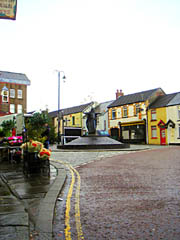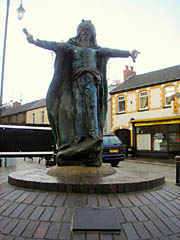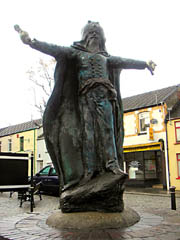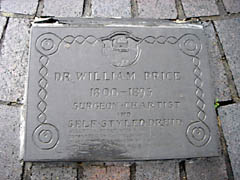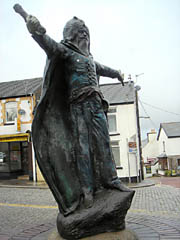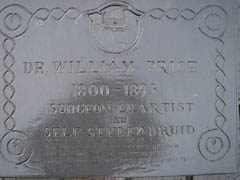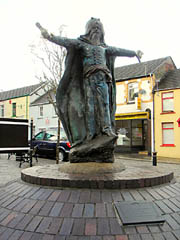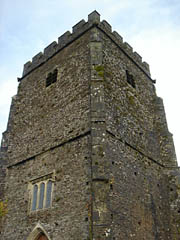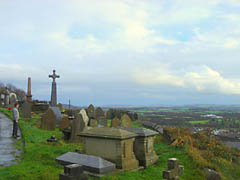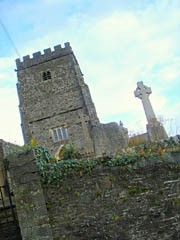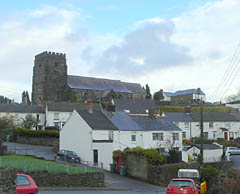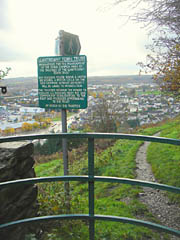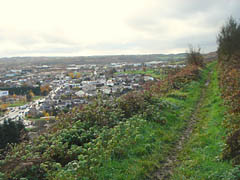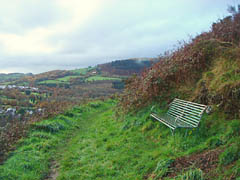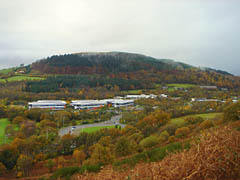Llantrissent (Llan-Tri-Sant) - From 'A Topographical Dictionary of Wales' (1849)
LLANTRISSENT (LLAN-TRI-SANT), a borough, market-town, and parish, in the union of Cardiff, hundred of Miskin, county of Glamorgan, South Wales, 10 miles (N. W. by W.) from Cardiff, and 169 (W.) from London; containing 3222 inhabitants. This place, which derives its name from the dedication of its church to three different saints, is distinguished by few historical events of importance. At what time or by whom its castle was originally built, is not accurately known; but it is enumerated among those for which Gilbert de Clare, commonly called "the Red," lord of Glamorgan, did homage to Edward I., on his accession to the titles and estates of his family, after the death of his father, towards the end of the thirteenth century. Edward II., with his favourite, the younger Spencer, was taken prisoner at or near this town, by the queen's forces. The town is romantically situated, on the road from Cowbridge to Merthyr-Tydvil, in a pass over a mountainous ridge, between two lofty hills. It is irregularly and indifferently built; but its whitewashed houses, with the dismantled tower of its castle, form conspicuous and pleasing features in the scenery on approaching the mountains. The vicinity is indescribably beautiful, and the views embrace a tract of country abounding with features of romantic character and almost unrivalled magnificence. From the brow of the hill on which the town stands is seen the whole of the Vale of Glamorgan, from its eastern extremity to the influx of the river Ogmore into the Bristol Channel: among the numerous interesting objects in this extensive tract of country, appear the rich woods about Hensol, Gl�nelay, and Llanharan; beyond which is discerned the Bristol Channel, with the distant hills on the English coast, and in other directions the lofty mountains that bound it on various sides. To the north of the town the country becomes more rugged, and assumes a wilder aspect, which is in some degree enlivened by the pleasing appearance of Castella, an ancient seat, forming a lively and cheerful object in a landscape whose prevailing character is a sombre magnificence. At the entrance of the town is a substantial stone mansion, called Llantrissent House.
The parish abounds with coal, which is worked to a very great extent for the supply of the iron-works in the neighbouring districts, and for exportation. Ores of iron and lead have also been found, and works were established here for procuring those minerals; but they were not conducted with a sufficient degree of profit to remunerate the adventurers, and consequently were discontinued. The principal of these deserted works was the Park mine, about a mile south of the town, the ore obtained in which was of the species called galena, or potters'-ore, lying in a vein extending from east to west, and contained in a matrix of spar, in magnesian limestone resting upon coal. Some time ago an ancient colliery, not properly filled up, was accidentally discovered by R. F. Rickards, Esq., who, by falling into it, was burnt to the bone on the fore part of the foot and leg. It contained a large quantity of pyrites, which had ignited, and had been in a state of combustion for a very long period; it is still burning, and probably will continue to burn, so long as any inflammable matter may remain. A tramroad extends from the Dinas colliery, north of St. John's, to Newbridge, five miles from Llantrissent; where the T�f-Vale railway and the Glamorganshire canal have their course. On the south-west of Llantrissent runs the great South Wales railway. The parish comprises 16,669 acres. The market, which is only for provisions, is on Friday: the corn market has been removed to Newbridge. Large cattle-fairs are held on February 13th, May 12th, August 12th, and October 29th.
It has not been precisely ascertained at what time the town received its first charter of incorporation, but it has a charter dated the 20th of Edward III. The corporation consists of the constable of the castle, a steward, portreeve, twelve aldermen, and an unlimited number of burgesses, assisted by a town-clerk, serjeant-at-mace, and other officers. A court leet is summoned by the portreeve twice a year, in the months of May and October, to be held before the constable of the castle, the steward, and the portreeve; on each of which occasions a jury of twelve persons is selected from the burgesses present, by the serjeant-at-mace, under the direction of the steward. At the court held in May the jury name four burgesses, of whom the constable of the castle chooses two to be overseers of markets for the ensuing year; they likewise make out further lists of burgesses, out of whom the same officer appoints four to serve as overseers of the commons, and eight as constables. At the court which takes place in the month of October, the jury nominate three of the aldermen, of whom one is selected by the constable of the castle to fill the office of portreeve; and the portreeve, in like manner, upon the presentment of three burgesses, appoints one of the number to be serjeantat-mace for the ensuing year. The freemen of the borough have a right of common upon about 300 acres of waste land.
Llantrissent was one of eight contributory places, namely, Cardiff, Llantrissent, Cowbridge, Aberavon, Kenvig, Neath, Swansea, and Loughor, which returned a member to parliament: the right of election was in the burgesses at large of the borough, about 420 in number. By the act of 1832, "for Amending the Representation of the People," the boroughs of Cardiff, Cowbridge, and Llantrissent were constituted a separate district, returning one member; and the right of voting was vested in the then resident burgesses of the borough, about 100 in number, and in those at that time living within seven miles, in number 112, if duly registered according to the provisions of the act; also in every male person of full age occupying, either as owner, or as tenant under the same landlord, a house or other premises of the annual value of not less than �10, provided he be capable of registering as the act directs. The present number of tenements of this value, within the limits of the borough, which extend about a mile from the town in every direction, comprising the whole of the town hamlet and part of one or more other hamlets, is twenty-five. No burgess created after the passing of the act, even though resident in the town, can vote, as a burgess, at a parliamentary election. The corporation are empowered by their charter to hold a court of record for the recovery of debts, but it has been for many years discontinued. The petty-sessions for the hundred of Miskin are held in the town every Friday.
The living is a vicarage, rated in the king's books at �26. 14. 2., and endowed with the vicarial tithes of the parishes of Aberdare, Lantwit-Vairdre, Llanwonno, and Ystrad-Dyvodog; present net income, �555, with a glebe-house; patrons and appropriators, the Dean and Chapter of Gloucester. The church, dedicated to St. Dyvnog, St. Iddog, and St. Menw, is a spacious and ancient structure, in the Norman style of architecture, occupying the summit of the hill above the town. There are two chapels in the parish. One is dedicated to St. John the Baptist, and its living is a perpetual curacy, endowed with �200 private benefaction, �1000 royal bounty, and �1000 parliamentary grant, and in the patronage of Mrs. Pritchard; net income, �95. The other, called T�lygarn, after being suffered to fall gradually into decay, has been repaired through the instrumentality of Dr. Lisle, who has a summer residence at this place. The living is a perpetual curacy, endowed with �1000 royal bounty; net income, �50; patrons, and impropriators, the Principal and Fellows of Jesus' College, Oxford. The Wesleyans, Baptists, Independents, and Calvinistic Methodists, have each a place of worship in the town; the Independents have additional meeting-houses at Cymmer and Crossvaen, and the Methodists one at Velin Vawr, within the parish. Altogether, there are nine or ten places of worship for these four denominations.
Day and Sunday National schools, for the instruction of both sexes, are supported by the Stuart family, Marquesses of Bute, who contribute fifty guineas per annum, and by subscription among the gentry resident in the neighbourhood. Some day schools at Dinas are maintained by a stoppage of one penny in the pound on the wages of the men employed in the coke-works there; and the dissenters have nine Sunday schools in the town and parish. Mr. Gibbon, of Newton House, in the parish of Llanblethian, bequeathed in 1809 a sum of �500, one-fifth, producing �4. 19. per annum interest, to be distributed among the poor of this place, at the discretion of the vicar; and, under the will of Sir Leoline Jenkins in 1685, a sum of �20 is given in clothing, every fourth year, by the master of Cowbridge school, to the poor of the parish, of whom the vicar nominates such as he thinks the most deserving. The same benefactor directed his executors to purchase the site of the chapel of ease called T�lygarn, and to put the same in good repair: he also charged his lands with an endowment of �10 per annum, for maintaining divine service in it, and gave to it " the chalice that he had used at Nimeguen." Catherine Powell, in 1739, charged a moiety of the lands of Trebannog, which she devised to her nephew, with the expense of maintaining a milch-cow throughout the year for the use of seven poor people about her mansion at Milton, and paying them seven half-crowns at Candlemas; but this charity has been discontinued for the last half century.
There are some small remains of the ancient castle, which originally comprised two wards, and appears to have been a place of great strength: these consist principally of a portion of one of the towers, which, from its elevated situation, forms a very conspicuous and interesting feature in the scenery of the place. In 1829, in clearing away the rubbish that had accumulated about the foundations, the workmen discovered the dungeon, which, according to Leland, once formed the prison for the territories of Miskin and Glyn Rhondda. At a short distance from the town, to the right of the road leading to Llandaf, are some remains of a religious house, said to have been dedicated to St. Cawrdav, son of Caradoc Vraichvras, regulus of Brecknock, about the end of the fifth, or the beginning of the sixth century. Within the limits of the parish are several camps, of which the most important is that called Caerau, or "the fortifications," supposed to have been constructed by the Danes. Castella, the old family mansion of the Trahernes, appears also from its name to have been built upon the site of some fortification, which may have been an outpost to the castle of Llantrissent. There are chalybeate springs in several parts. Sir Leoline Jenkins, who, in the reign of Charles II., was eminently distinguished as a jurist, diplomatist, and statesman, was born in this parish, and was buried in the chapel of Jesus College, Oxford, to which he had been so munificent a benefactor as to be in some degree regarded as its second founder: he endowed the grammar school at Cowbridge, and bequeathed the principal part of his estates to charitable uses. |


